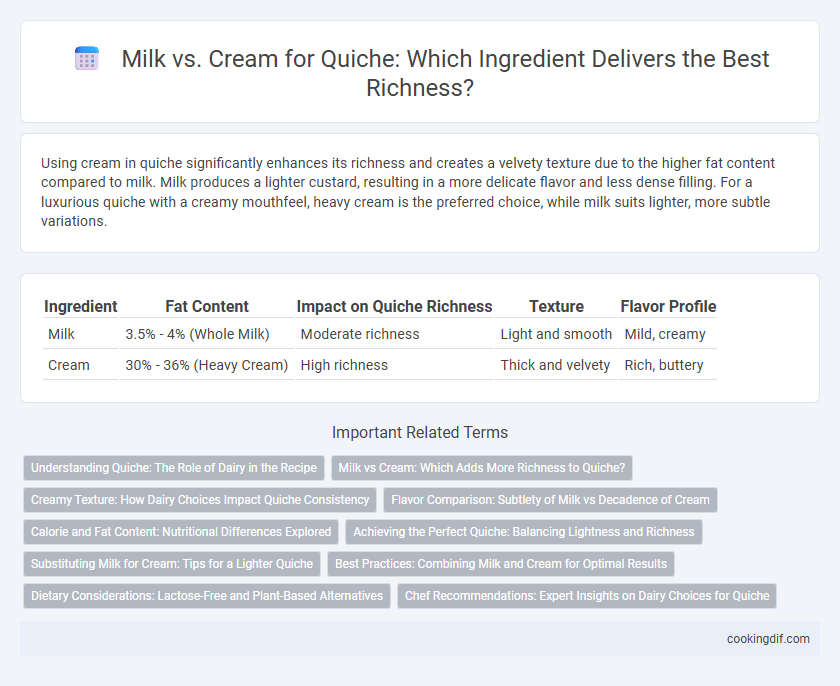Using cream in quiche significantly enhances its richness and creates a velvety texture due to the higher fat content compared to milk. Milk produces a lighter custard, resulting in a more delicate flavor and less dense filling. For a luxurious quiche with a creamy mouthfeel, heavy cream is the preferred choice, while milk suits lighter, more subtle variations.
Table of Comparison
| Ingredient | Fat Content | Impact on Quiche Richness | Texture | Flavor Profile |
|---|---|---|---|---|
| Milk | 3.5% - 4% (Whole Milk) | Moderate richness | Light and smooth | Mild, creamy |
| Cream | 30% - 36% (Heavy Cream) | High richness | Thick and velvety | Rich, buttery |
Understanding Quiche: The Role of Dairy in the Recipe
Quiche richness primarily depends on the type of dairy used, with cream offering a higher fat content of about 30-36%, which results in a silkier, more decadent texture compared to milk's lower fat percentage of 3-4%. Using heavy cream enhances the custard's creaminess and stability during baking, maintaining a luscious, smooth consistency. Milk, while lighter and less rich, can yield a more delicate quiche but may lead to a slightly firmer and less velvety filling.
Milk vs Cream: Which Adds More Richness to Quiche?
Cream adds significantly more richness to quiche than milk due to its higher fat content, typically around 30-36%, which results in a creamier, more luxurious texture and deeper flavor. Milk, containing roughly 3-4% fat, creates a lighter, less dense custard that allows other ingredients to shine without overwhelming richness. For a balance, some recipes combine milk and cream to achieve optimal richness and texture tailored to taste preferences.
Creamy Texture: How Dairy Choices Impact Quiche Consistency
Using cream in quiche enhances the creamy texture due to its higher fat content, which results in a richer, smoother consistency compared to milk. Milk, with lower fat levels, produces a lighter, less dense custard, offering a more delicate bite. Choosing cream intensifies the mouthfeel and flavor depth, making the quiche decadently creamy and luxurious.
Flavor Comparison: Subtlety of Milk vs Decadence of Cream
Milk imparts a lighter, more delicate flavor to quiche, allowing the natural taste of vegetables and other ingredients to shine through with subtlety. Cream, by contrast, adds a rich, velvety texture and intensifies the quiche's decadence through its higher fat content. Choosing between milk and cream ultimately influences the quiche's mouthfeel and depth of flavor, with cream offering a more indulgent and luscious result.
Calorie and Fat Content: Nutritional Differences Explored
Milk contains significantly fewer calories and less fat compared to cream, making it a lighter option for quiche richness without sacrificing flavor. Cream, rich in saturated fats and higher in calories, adds a decadent, velvety texture and deeper mouthfeel to quiche, intensifying its indulgence factor. Choosing milk reduces overall calorie intake and saturated fat, but using cream enhances the quiche's creamy consistency and luxurious taste, influencing dietary and flavor preferences.
Achieving the Perfect Quiche: Balancing Lightness and Richness
Using milk in quiche results in a lighter, more delicate texture, while cream enhances richness and creates a custard that is velvety and indulgent. A balanced quiche often combines both milk and cream to achieve a perfect harmony of lightness and richness, ensuring a tender yet flavorful filling. Adjusting the ratio of milk to cream allows for precise control over the quiche's consistency and depth of flavor, catering to different taste preferences.
Substituting Milk for Cream: Tips for a Lighter Quiche
Substituting milk for cream in quiche significantly reduces fat content while maintaining a smooth texture, ideal for a lighter dish. Using whole milk or 2% milk provides enough creaminess without overpowering the flavor, whereas skim milk may result in a less rich custard. For enhanced richness, blending milk with a small amount of cream or adding a touch of melted butter can achieve a balanced, lighter quiche.
Best Practices: Combining Milk and Cream for Optimal Results
Combining milk and cream in quiche recipes balances richness and texture, with cream providing a luxurious, custard-like consistency while milk lightens the mixture for a smoother bite. The best practice involves using a ratio of 1 part cream to 2 parts milk, ensuring a creamy yet not overly heavy filling. This combination enhances flavor depth and prevents the quiche from becoming too dense or greasy.
Dietary Considerations: Lactose-Free and Plant-Based Alternatives
Quiche recipes often call for milk or cream to achieve desired richness, but lactose-free milk and plant-based alternatives like almond, soy, or oat milk provide excellent options for those with lactose intolerance or dietary restrictions. Coconut cream or cashew cream can effectively replace traditional dairy cream, delivering a creamy texture while remaining vegan-friendly. Incorporating these substitutes maintains the quiche's richness without compromising dietary needs or flavor.
Chef Recommendations: Expert Insights on Dairy Choices for Quiche
Chefs recommend using heavy cream over milk for quiche to achieve a richer, creamier texture, as cream's higher fat content enhances the custard's silkiness. Milk, especially whole milk, provides a lighter, less dense filling, which some chefs suggest for a more delicate quiche. Many culinary experts emphasize balancing dairy richness with other ingredients to maintain the desired quiche consistency and flavor depth.
milk vs cream for quiche richness Infographic

 cookingdif.com
cookingdif.com